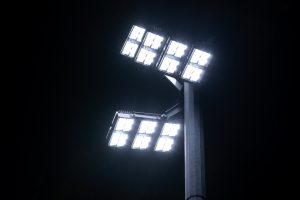Illuminating Success: The Power of Lighting Design in Sports Venues

Lighting is a significant factor in the design and updating of sports venues – with its primary function being to enhance visibility and uphold safety. As a result, high-quality and long-lasting technology and equipment is essential, as is a sound understanding of the technical aspects, such as the required lux levels of the entire project.
Martin Heaward, UK Head of Sales at Performance iN Lighting (Powered by Gewiss) explains what ‘good lighting design’ really means, and how partnering with lighting suppliers that boast decades of expertise can help you get the most out of your project:
“Lighting design is a relatively straightforward concept, but is incredibly complex in practise and vitally important. Adequate lighting plays an integral role in almost every project, and especially so in sports settings – with children and adults likely using the facilities at all hours of the day, it’s essential that areas are well-lit to avoid risk of injury, danger or harm.
“For this reason, the best projects are those that bring in a lighting partner from the very beginning, allowing for standards and specifications to be met, any unexpected challenges overcome, and all deadlines adhered to. In order to get it right – first time – the following must be considered:
Setting & Layout
“One of the first things to understand is the setting – in its entirety. Understand whether the luminaires are to be located internally or externally (or both), the positioning of other items (such as walls, ceilings, grandstands, and walkways), and any other components that might impact the lux levels.
“Often, sports facilities can have multiple areas – for example: an external football pitch and running track, as well as an indoor swimming pool, sports hall, and cafe. Ensuring that all can be suitably lit simultaneously is a must, meaning meticulous planning must be undertaken.
“Many designers can use 3D simulations to create a replica of reality. These can provide initial indications of any false colour renderings, light spill or where wattage (and subsequent costs) might be wasted. When armed with this information, the lighting team can carefully calibrate all external factors to craft and install the most efficient lighting solution.
Ease of Access
“Choosing components that boast quality, robustness, and longevity should always be key. However, luminaires and other components naturally have a lifespan and will at some stage require replacement or repair. Therefore, installing items that allow for internal workings to be easily accessed ensures limited downtime when these instances occur. Also, opting for products that incorporate the latest technologies, such as maintainable LEDs and LED Drivers, ensures that the luminaire is future-proofed, saving time, money, and labour-extensive resources.
Compliance
“As with any project – especially one which is designed to accommodate the public on a regular basis – it’s important that all items meet stringent standards.
“Partnering with lighting teams that have extensive technical knowledge and sector experience allows you to adopt ‘good’ lighting design – able to access up-to-date information about the industry, utilise the latest technologies, and rest assured that the lighting solutions will achieve the very best results for its entire lifetime.”
About Performance iN Lighting
Headquartered in Verona, Italy with operations across more than 100 countries worldwide, Performance iN Lighting (Powered by Gewiss) is an established global player, manufacturing lighting products to enhance both public and private spaces. Following phenomenal success across Europe for the past decade, they officially launched in the UK market in 2023. For more information about their extensive product range, visit the website: www.performanceinlighting.com/gb/en/.


